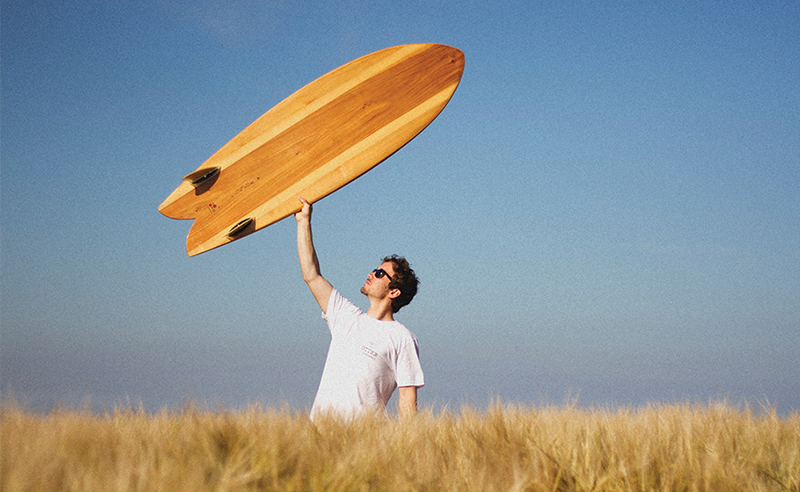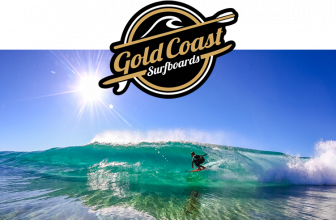
The Fish surfboard was born in 1967 in a small Southern California town called Point Loma.
Steve Lis, now one of surfing’s most famous designers, shaped the fist fish after finding a longboard that was snapped in half.
It was made so that he could kneeboard around the large, hollow reef breaks that were sprinkled around San Diego County.
Eventually, after testing it himself, Steve gave a few to his kneeboarding friends to test out as well.
At this point, the Fish was still very much underground.
The first person to actually use it as a standing surfboard was Jeff Ching, a surfing buddy of Steve’s.
With Steve’s 4’7” board, Ching paddled out and carved the first ever standing fish wave in history.
After borrowing his board, Ching asked Steve to make him a board that was a bit larger and more versatile.
Therein came Ching’s famous photograph of the first 5’5” fish ride. Like all good things though, the design of the Fish found its way into the hands of the world.
How Did These Boards Become So Popular?
In 1972, the World Championship was being held in San Diego. Two locals, Jim Blears and David Nuuhiwa, ended up taking their fishes out into the waist-high surf that day and totally wiped the competition. It was at that moment that the fish had gone viral. Essentially, people were so baffled as to what these boards allowed Blears and Nuuhiwa to do in conditions that were pretty subpar.
After the championship was over, new fish shapers took the design to the drawing board to begin highlighting certain characteristics so that it could truly excel in small wave conditions. Because of this, the fish was no longer for head high waves, and the design that we know and love today became cemented in history.
So What Is A Fish Surfboard Exactly?
Fish boards look a lot like shortboards, but have small nuances that actually make them quite different. For starters, fish surfboards have much more volume than shortboards, making them more buoyant and easier to paddle on in smaller surf. They’re also much wider that shortboards as well, mostly to make up for the face that they are short and stubby.
The reason why they call at the fish? Well, just look at the profile. It’s like surfing a big goldfish cracker. The swallowtail mimics that of a little fishy and the flat rocker almost makes it look like you could have the two fish eyes on either side.
Why Did the Fish Surfboard Catch On?
The fish surfboard caught on mostly because it was easy to surf in smaller conditions. Mush, slop, chop, whatever, a fish could take it on. Obviously surfer could have taken longboards out, but then they were sacrificing speed. While the fish worked for many surfers, it still had limitations. The true spread of the fish began as shapers started tweaking the design to make it more adaptive for outlier surfers. One example is Mark Richards, a 6’1” competitive surfer who was around in the 1970s.
The boards were too short, the tails weren’t narrow enough to provide enough maneuverability, and the single fin design wasn’t versatile enough. He was able to popularize boards that took these traits and flipped them, giving the fish a new face that would live on.
Why Should I Add a Fish Surfboard To My Quiver?
Beyond catching small waves, modern fish surfboards are very versatile. Because they have much more volume than a regular shortboard, they’re much easier to paddle and pop up on. The ease in paddling also has to do with the fact that the rocker is so flat.
Unlike a longboard, it is very possible to use the fish for tricks and maneuvers in smaller conditions as well. Most people believe that the fish is just meant to gain speed in small waves, though it definitely holds the key for much more. While not as maneuverable as a shortboard, you really can’t get anything better to perform on mushy days.
Final Thoughts?
Fish surfboards nowadays seem to be a lot more diluted than they maybe were intended to be originally. Some fish retain the small length and profile while other use the profile but extend the length to make it better for bigger waves. Fishes are being shaped for specific needs and being tuned to the point that they are pretty much hybrids of different boards.
With all that said, the fish is a classic, and easily one of the coolest boards around. Anyone who tells you they are kooky has never ridden one. We expect that they’ll one day become unrecognizable through evolution, so do yourself a favor and ride one now!





